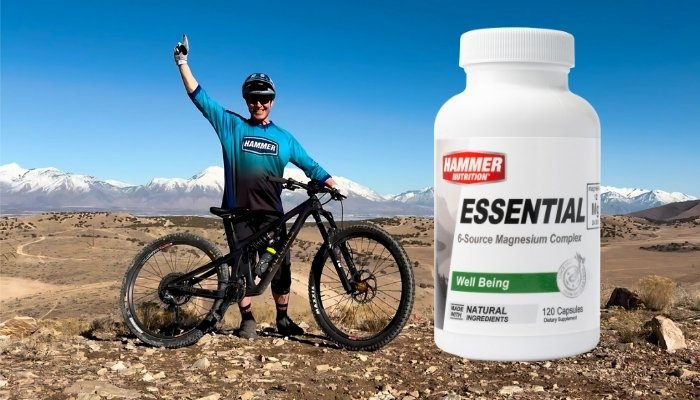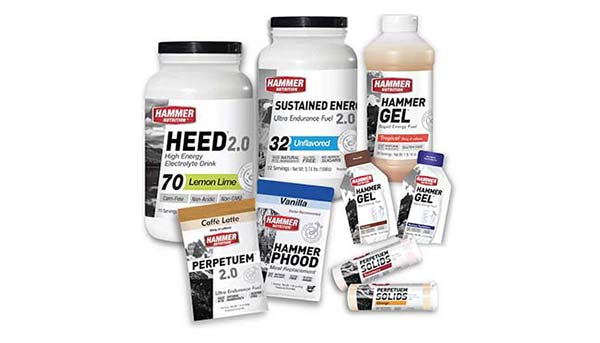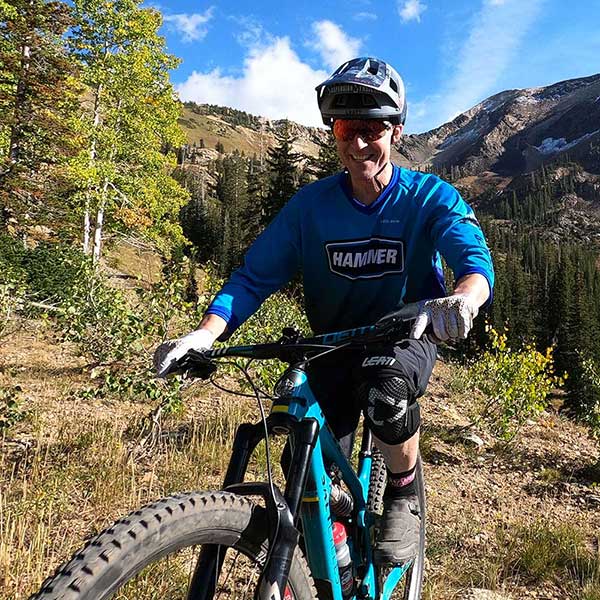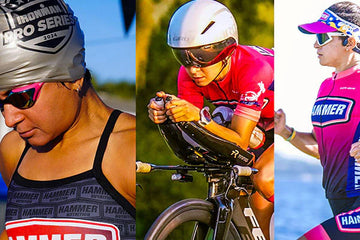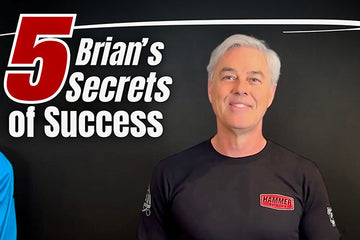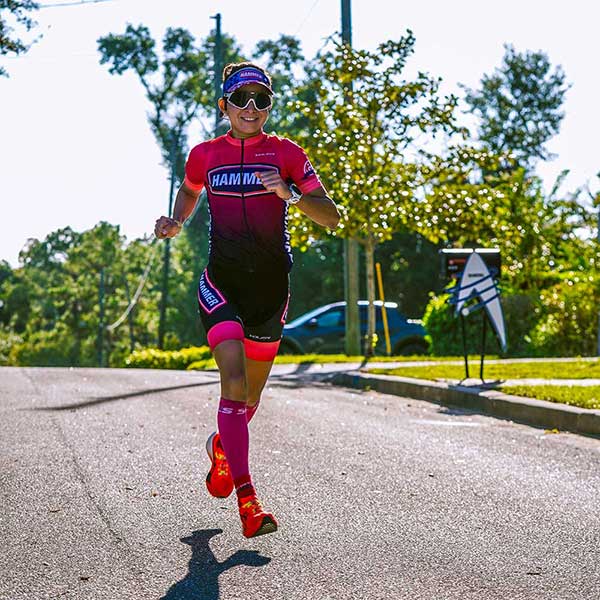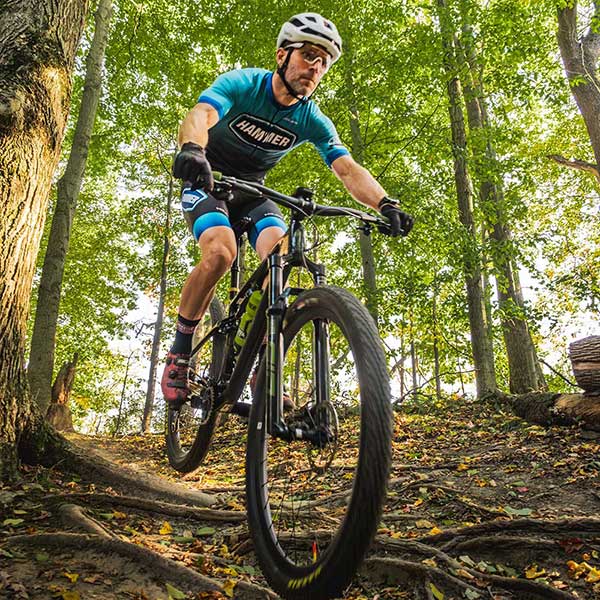By Steve Born
How your cooling system works
When we exercise, we burn molecular fuel (mostly glycogen). But we also burn some protein, fat, and blood glucose from ingested nutrients. The breakdown of these energy providers releases heat. That builds up and raises our core temperature. The body must rid itself of this heat and maintain a core temperature within a few degrees of the well-known 98.6° F (37° C). An active person needs a reliable cooling mechanism.
Actually, you have several. You lose some heat through your skin. Blood carries heat to the capillaries near the skin's surface, removing heat from the body core. You breathe harder to get more oxygen, expelling heat when you exhale. But by far the most important part of the cooling system, accounting on average for about 75% of all cooling, is your ability to produce and excrete sweat.
Sweat, however, glistening on your forearm or soaking your singlet won't cool you. It must evaporate. Sweat works on a basic physical premise: water evaporation is an endothermic process, requiring energy (heat) to change from liquid to gas. Thus, water molecules in the gas phase have more energy than water molecules in the liquid phase. As water molecules evaporate from your skin, they remove heat energy. The remaining water molecules have less energy and you feel cooler. Isn't that cool?
Weather conditions greatly affect sweat production and cooling effectiveness. In cool weather, you get substantial cooling from the heat that escapes directly from your skin. As the temperature increases, you gradually rely more on evaporation. On hot days, with little difference between skin surface and ambient temperatures, your skin surface provides only negligible convective cooling and you'll need to sweat more to maintain a safe internal core temperature. At 95° F (35° C) or above, you lose no heat at all from your skin and in fact, you actually start to absorb heat. Evaporative cooling must do all of the work.
Humidity is the other major factor that affects sweat. On humid days, sweat evaporates more slowly because the atmosphere is already saturated with water vapor, retarding the evaporation rate. The sweat accumulates on your skin and soaks your clothes, but you don't get any cooling from it because it's not going into the vapor phase. Soaking, dripping sweat may give you a psychological boost, but it has no physical efficacy to cool. Sweat must evaporate to remove heat. On days when it's both hot and humid, well, you don't need to read about what's going to happen when you exercise in those conditions. You do need to know that under the worst of conditions you can produce up to three liters of sweat in an hour of strenuous exercise, but your body can only absorb about one liter from fluid consumption. Yes, this will cause problems before long, and we will discuss that issue below.
What happens when the coolant runs low?
Just like a car, your body must dissipate the excess heat generated from burning fuel. Unlike a car, your body's coolant isn't in a sealed internal system. You use it once and then it's gone and needs to be replaced. Unfortunately, we don't come with built-in gauges or indicators that tell us just how much coolant we have left in our system. We can't run a dipstick down our gullet and get a reading that says, "add a quart." We do have some physiological signs, but they function at the 'Warning-Danger!' level, too late to maintain optimal performance. For instance, by the time you feel thirsty, you could have a 2% body weight water loss, already into the impairment zone.
The chart below shows what happens to human performance at each percent of weight loss. By weight loss, we mean the percentage of your body weight at the start of exercise that you have lost at the end via sweat. If you go out for a run at 160 pounds (approx 72.5 kg) and weigh in 20 miles later at 154 (approx 70 kg), you've lost almost 4% of your body weight. That's too much to maintain your pace to the end, let alone expect to kick.
Symptoms by percent body weight water loss:
- PERCENT WATER LOST --------- SYMPTOMS
- 0% --- none, optimal performance, normal heat regulation
- 1% --- thirst stimulated, heat regulation during exercise altered, performance declines
- 2% --- further decrease in heat regulation, hinders performance, increased thirst
- 3% --- more of the same (worsening performance)
- 4% --- exercise performance cut by 20 - 30%
- 5% --- headache, irritability, "spaced-out" feeling, fatigue
- 6% --- weakness, severe loss of thermoregulation
- 7% --- collapse likely unless exercise stops
- 10% -- comatose
- 11% -- death likely
[Nutrition for Cyclists, Grandjean & Ruud, Clinics in Sports Med. Vol 13(1);235-246. Jan 1994]
How much is that?
As you can see from the chart above, sweat loss can easily escalate from an athletic performance issue to an acute medical issue. Clearly, we need to have some quantifiable idea of our intake and output. Let's start with converting the data on the chart to recognizable amounts. Perhaps you remember the saying, a pint's a pound, the world 'round. Now that's a convenient conversion for endurance athletes. Here's another: one pint = one water bottle. Some bottles hold 20 ounces (approx 590 ml), but consider a regular water bottle as a pint (16 ounces/approx 475 ml). Two pints make a quart (32 ounces), which is equivalent to almost a liter - not quite, but almost. So when you read liter, think two water bottles. Losing one pound of weight (slightly less than half a kilogram) means a one-pint loss. One liter (or one quart) is about two pounds (nearly one kilogram).
Can you drink enough?
Needless to say, maintaining optimal fluid intake prior to and during exercise is crucial for both performance and health. However, as is true with calories and electrolytes, you can't replenish fluids at the same rate you deplete them. Your body simply won't absorb as fast as it loses it. Evaporative cooling depletes fluids and electrolytes faster than the body can replenish them. Your body will accept and utilize a certain amount from exogenous (outside) sources and similar to calories and electrolytes, maintaining fluid intake within a specific range will postpone fatigue and promote peak performance.
Research suggests that while electrolyte needs for individual athletes may vary up to 1000% (tenfold), fluid loss remains fairly constant. Also, we can measure fluid loss more easily than electrolyte loss. We don't need sophisticated lab equipment, just a scale. Thus, we can come pretty close in calculating fluid loss and replacement.
The numbers
On average, you lose about one liter (approx 34 ounces) of fluid per hour of exercise. Extreme heat and humidity can raise that amount to three liters in one hour. A trained athlete will store enough muscle glycogen to provide energy for approximately 90 minutes of aerobic exercise. As your muscles burn glycogen, water is released as a metabolic by-product and excreted as sweat. Researchers found that during a marathon (26.2 miles), runners released an average of two liters of sweat from muscle glycogen stores. This is in addition to sweat from other body liquids.
You can control or lessen these sweat rates by acclimatization and training for the event. Acclimatized athletes can reduce electrolyte and fluid loss up to 50%, but note that those losses cannot be fully replaced during the event. Remember the words of Dr. Bill Misner (mentioned in the LESS IS BEST - The right way to fuel* article), The endurance exercise outcome is to postpone fatigue, not replace all the fuel, fluids, and electrolytes lost during the event. It can't be done, though many of us have tried. In other words, our hydration goal is not to replace water ounce-for-ounce or pint-for-pint, but to support natural stores by consuming as much as we can adequately process during exercise.
At the most, you can absorb about one liter (approx 34 fluid ounces) of water per hour, but only in the most extreme heat and humidity. Most of the time you can only absorb about half or not too much over half that amount, even though it won't fully replace your losses. Repeated intake of one liter (about 34 fluid ounces) per hour will ultimately do you more harm than good.
Can you drink too much?
Ironically, while you can't drink enough to replace all fluid lost, you can drink too much. Researchers have noted the dangers of excess hydration during events lasting over four hours. Dr. Tim Noakes collected data for ten years from some 10,000 runners participating in the Comrades Marathon. This 52.4-mile (84.33 km) race, held each June (winter) in South Africa, ranks as one of the world's premier ultra-marathons. Noakes showed that endurance athletes who consumed from 16-24 fluid ounces per hour (approx 475-710 milliliters) typically replenished as much fluid as is efficiently possible. He also noted the prevalence of hyponatremia (low blood sodium) during ultra-marathons and triathlons in runners who hydrated excessively. This condition can arise from several different physiological scenarios. For endurance athletes, it usually results from sweat-depleted sodium stores diluted by excess hypotonic (low electrolyte content) fluid intake. When blood sodium concentration becomes too dilute, you can develop severe cardiac symptoms leading to collapse.
Problems with too much or too little
Moreover, Noakes noted a pattern of hydration problems among race participants. In ultra events, the leaders usually dehydrate, but the athletes in the middle-to-back of the pack tend to overhydrate. Both may end up suffering from the same hyponatremic symptoms. The former from too little fluid intake combined with too much sodium loss due to profuse sweating, the latter from too much fluid intake and relatively less sodium loss. Because most front-runners are extremely competitive, they don't stop long enough during the race to overhydrate. In addition, it's highly likely that elite athletes may be fitter and better acclimatized to deal with hot weather conditions. A tendency to linger at aid stations, attempting to relieve the symptoms of fatigue or heat by drinking too much water, is a fault found among the majority of the remainder of athletes, those in the middle or back of the pack. Also, these athletes may be novices who have heard the "drink, drink, drink" mantra but who haven't had enough experience to personally calibrate their individual needs. After the 1985 Comrades race, 17 runners were hospitalized, nine with dilutional hyponatremia. In the 1987 Comrades Marathon, 24 runners suffered from dilutional hyponatremia. These athletes had seriously overloaded on fluid intake, with the inevitable result of a totally disrupted physiology.
Tragic consequences
Hyponatremia usually results from drinking too much, especially when one drinks fluids such as plain water or a sports drink lacking the proper electrolyte profile. Training and fitness levels, weather conditions, and, undoubtedly, biological predisposition also contribute to developing this form of hyponatremia known as water intoxication.
Sadly, we must note that this condition has led, directly or in part, to the deaths of otherwise healthy runners in major American marathons. It is hard for us to comprehend the grief of the families they left behind. These athletes went out to run a marathon, to achieve a personal victory. Improper hydration took away their day of glory and also their lives. They collapsed and went into an irreversible condition involving uncontrollable brain edema, coma, and death. We report this to help prevent any future such tragedies. Overhydration represents a very serious problem. Unlike dehydration, which will generally only result in painful cramping, possibly a DNF, or at the worst, IV treatment, overhydration can incite a chain of ultimately fatal physiological consequences.
So how much, how often?
The extreme cases cited above happen very rarely. Lesser degrees of impairment occur frequently from excessive fluid intake. We don't have a chart for overhydration similar to the one for dehydration. Also, you probably don't carry a scale or have regular access to weigh-ins along your training route. So how do you know when it's time to drink? You don't wait until you're down a quart. A good hydration regimen starts before you even get moving.
Noakes believes intake of hypotonic fluids of one liter/hr (33.8 oz/hr) will likely cause water intoxication and dilutional hyponatremia. He suggests that athletes may do better on 500 ml/hr (approx 17 oz/hr) fluid intake for ultra events performed in hot weather conditions. In "The Top Ten - The biggest mistakes endurance athletes make" article, Dr. Ian Rogers suggests that 500-750 ml/hr (about 17-25 oz/hr) will fulfill most athletes' hydration requirements under most conditions. According to Dr. Rogers, "like most things in life, balance is the key." The balance is likely to be at a fluid intake not much above 500 milliliters (about 17 ounces) per hour in most situations, unless predicted losses are very substantial. Other research suggests a similar consumption of 4.5-7.0 oz (approx 133-207 ml) of water every 15 to 20 minutes of exercise.
How much fluid should you drink? |
||
| Average athlete, average temps | Lighter athletes or cooler temps | Heavier athletes or hotter temps |
| 20-25 oz/hr (approx 590-740 ml/hr) is an appropriate fluid intake for most athletes under most conditions. | For lighter weight athletes, or those exercising in cooler temperatures, 16-18 oz/ hr (approx 473-532 ml) may be perfect. | Heavier athletes or athletes competing in hotter conditions may consider intakes upwards of 28 oz/hr (approx 830 ml/hr). |
Based on the available research, along with the thousands of athletes we have monitored, we have found that 20-25 oz/hr (approx 590-740 ml/hr) is an appropriate fluid intake for most athletes under most conditions. For lighter weight athletes, or those exercising in cooler temperatures, 16-18 oz/hr (approx 473-532 ml) may be perfect. Heavier athletes or athletes competing in hotter conditions may consider intakes upwards of 28 oz/hr (approx 830 ml/hr). We also suggest that to avoid dilutional hyponatremia, fluid intake should not routinely exceed 28 oz/hr (830 ml/hr). The exceptions are heavier athletes, athletes exercising at extreme levels (prolonged periods at a high percentage of VO2Max), and athletes competing in severe environmental conditions.
20-25 oz (approx 590-740 ml) is the equivalent of the typical regular-to-large size water bottle, and that’s an excellent gauge to work within.
Remember your electrolytes and calories!
We noted at the beginning of this article that besides cooling, water also plays an important role in nutrient transport. Water consumption bears directly on electrolyte and caloric uptake. You must consider the electrolyte content of your fluid intake, especially if you exceed about 24 oz/hr (710 ml/hr). If temperature and humidity rise above 70° F (21° C) and/or 70% humidity, we recommend that you take electrolytes before and during every hour of exercise. For a full discussion of electrolyte needs, see the article ELECTROLYTE REPLENISHMENT - Why it's so important and how to do it right.*
In addition, avoid fructose or other simple sugar-based drinks and gels, especially in the heat - unless you want to deal with a gastric emptying problem, which may result in nausea and other stomach maladies. Compared to complex carbohydrates, drinks or gels that contain simple sugars (typically glucose, fructose, and sucrose) require more fluid and electrolytes for effective absorption. Because they require more fluid, you get fewer calories per unit of water. You must restrict simple sugar drinks to a 6-8% solution range, which provides inadequate amounts of calories for energy production. You can make a nice drink in a water bottle that will absorb well and provide adequate fluid, but your caloric intake will fall far short of your body's needs and your energy level will suffer.
If you make a double or triple-strength batch of a simple sugar drink hoping to obtain adequate amounts of calories, you'll require additional fluids and electrolytes to efficiently process the sugar. You will need to guess how much extra water and electrolytes your body needs to handle the sugar. If you guess low, your GI tract will be forced to pull minerals and fluids from other areas of the body. This scenario can cause nauseating results as your body literally dehydrates its working muscles while bloating your belly. Why take chances like that when your performance is on the line?
Your wisest choice is to use fuel comprised of complex carbohydrates, which is the carbohydrate source of all the Hammer Nutrition fuels. Even at a 15-18% concentration, these fuel sources absorb and digest rapidly, do not require excess fluid for transport through the GI system, and provide all of the calories your liver can process. For more details on fueling, see the article PROPER FUELING - Pre-workout & race suggestions*
Beat the HeatTips to keep cool |
||
| A cold, wet towel, sponge, hose, or sprayer on the head and torso. | If you're running, take a one-minute walk, douse yourself with water, and take a good drink. | If you're cycling, find a spot for a good coast or easy spin for a minute. The break from heavy exertion allows dissipation of internal heat. |
| Combined with hydration and external water, these ideas can effectively relieve heat stress, allowing you to finish hot weather endurance events. Highly competitive athletes might scoff at walking, but when it comes to core temperature, nature gives you two choices: cool down or DNF. | ||
Multi-hour bottles of fuel - A convenient way to monitor fluid and calorie intake
If you're going to be exercising for several hours, a convenient and time-efficient way to fuel (while also helping you monitor calorie and fluid intake with greater precision) is to make concentrated, multi-hour bottles of Sustained Energy or Perpetuem. This is discussed in the article **"The Hammer Nutrition Fuels found in the supplement to this book. However, since the topic here is hydration, presenting this information now is relevant.
Each scoop of Sustained Energy and Perpetuem that you put in a bottle reduces the water volume by about 1.5 ounces (approx 44 ml). For example, if you add two scoops of Perpetuem to a 21-ounce (approx 620 ml) water bottle, you won't end up with that same amount of actual fluid. It will be approximately 18 oz (roughly 502 ml), perhaps even slightly less. For some athletes, 18 oz/hr is sufficient, but for many athletes that's not enough. Oftentimes, upwards of 25-28 oz (approx 740-830 ml) of fluid are required hourly. As a result, you'll have to drink your entire fuel bottle, plus plain water from another source. After awhile it can be difficult to keep precise track of your fluid intake because you're fulfilling your needs from two separate sources.
To make things easier when doing a three-hour or longer workout, we suggest making concentrated, multi-hour bottles of fuel. For example, if you're going to be exercising for four hours and you know that you need two scoops of Perpetuem to satisfy an hour's worth of fueling, make an 8-scoop bottle in a 21-ounce (approx 620 ml) water bottle. Now, you have four hours of fuel in one bottle and that provides a number of benefits:
- Because you have four hours of fuel in one bottle, you only need to drink one-fourth of that bottle hourly, which means you don't have to drink a full bottle of flavored liquid hour after hour.
- You don't need to stop every hour to make more fuel because you've got four hours in one bottle.
- You can drink and enjoy plain water from another source (another bottle, hydration system) to cleanse the palate and satisfy hydration needs.
Yes, there is some actual fluid left in that 8-scoop/4-hour bottle of Perpetuem, but the amount is small, yielding less than four ounces (approx 118 ml) hourly over the course of four hours. Does that small amount of fluid count towards fulfilling your overall hydration needs? Yes, but it's a small enough amount to not have to think about if you're keeping your overall fluid intake within our suggested guidelines (approximately 20-25 oz / 590-740 ml hourly). Plus, those hourly guidelines do have some flexibility built in (+/- 3-4 oz or approx 89-118 ml).
With that in mind, a concentrated bottle of Perpetuem can thus be thought of as a calories only bottle and you'll fulfill your hydration needs with plain water from another source. The beauty of this, among the other benefits mentioned earlier, is that because you're fulfilling your calorie and fluid needs from sources independent of each other, you're able to gauge your intake with greater precision.
So when your workouts are greater than three hours in length, give the multi-hour bottle of Sustained Energy or Perpetuem a try. You'll find that it'll be a lot easier to keep track of both your calorie and fluid intake. It's been a winning strategy for thousands of endurance athletes.
Other ways to cool yourself in extreme heat
Although not directly related to actual water consumption, an external water application can help cool you. A cold, wet towel, sponge, hose, or sprayer on the head and torso can effectively lower body temperature, especially during a one-minute break. If you’re running, take a one-minute walk, douse yourself with water, and take a good drink. If you’re cycling, find a spot for a good coast or easy spin for a minute. The break from heavy exertion allows dissipation of internal heat. Combined with hydration and external water, this can effectively relieve heat stress, allowing you to finish hot weather endurance events. Highly competitive athletes might scoff at walking, but when it comes to core temperature, nature gives you two choices: cool down or DNF.
Fluid intake suggestions apart from the workout or race
Now that you have a good guide for your fluid intake during exercise, we can turn to two other considerations: how much you should drink overall during the day and how you should hydrate just prior to racing or exercise. For your regular daily hydration needs (that is, in addition to your exercise-induced needs), no research has conclusively arrived at an RDA for fluids, but about 0.5-0.6 fluid ounces per pound of body weight (roughly 33-39 ml/kg) makes a more accurate standard than the eight glasses a day commonly recommended for everyone. Multiplying your body weight in pounds by 0.5-0.6 will give you the figure, in fluid ounces, that you should aim for daily. Metrically, you'll multiply your body weight in kilograms by about 33-39 and that'll give you a good estimate, in milliliters, of what you should be drinking daily. Caveat: If you have not been following this recommendation consistently, you'll want to start increasing your daily water consumption gradually until you reach your target amount. If you increase your fluid intake too quickly, it will overwhelm your body with too much fluid too soon which may increase the potential for hyponatremia.
For satisfying hydration requirements prior to a workout or race, there have been a number of recommendations presented over the years. These are the two that we believe to be the most sensible, the ones that will satisfy hydration needs without putting you at the risk for overhydration:
- One liter of fluid (about 34 ounces) in the two hours prior to the start (about 17 ounces/500 milliliters per hour), ceasing consumption about 20-30 minutes before you begin the workout or race.
- 10-12 ounces (approx 295-355 milliliters) of fluid each hour up to 30 minutes prior to the start (24-30 ounces total fluid intake).
Keep in mind that even though these are our recommendations, you need to determine what works best for your system and the particular logistics of the race or training session ahead.
Personalized data is the key to hydration efficiency
We offer no "one size fits all" remedies. We do offer prudent and scientifically substantiated advice. We have given you some guidelines to start your assessment and calculation of your personal hydration needs. Each athlete is personally responsible for including hydration, fueling, and electrolyte replacement regimens into his or her training program. You must find out in practice—before competition—what works for you. Most of you will find your final figures will come very close to our suggested starting points. For others, you might find that in certain instances your needs in a particular event will require substantial modification.
If you've spent money on a heart rate monitor, a multi-function watch, or a body fat measuring device, and if you use them properly, you already have some serious training tools. We suggest that a good scale (preferably one that can measure less than one pound increments, such as a balance scale) may well prove to be your most valuable fitness investment. Weigh yourself before and after each outing, carefully noting the time, exertion level, miles, weather, and fluid, fuel, and electrolyte consumption. Another low-tech hint: make sure you know the capacity of your water bottles and hydration packs. Once you begin to log your fluid consumption and weight fluctuations, you'll have the data to accurately calculate your personal needs in this absolutely vital area.
Final checklist, some quick tips, and summary
1.) If you finish an event weighing the same or more than when you started, you have overhydrated. If you’ve dropped 3% or more, dehydration has occurred. Up to 2% weight loss is safe and reasonable.
2.) For very long events, such as a century bike ride, the average rider will also lose a pound or more in energy stores (glycogen, fat, and muscle tissue) in addition to the water, so figure that into your weight difference.
3.) Don’t assume that you can drink unlimited amounts of water or fluid during exercise and expect that all of it will be absorbed and the excess will be lost in sweat or through the kidneys. You will instead bloat, dilute your blood, urinate excessively, and develop water intoxication.
4.) Train to get fit in the heat. Heat acclimatization and fitness reduce fluid and electrolyte losses by up to 50%.
5.) Wear the lightest, most evaporation-friendly clothing you can afford. Cotton isn’t on the list. Many fibers today provide superior wicking and evaporation that allow your sweat to do the work nature intended.
6.) In general, keep fluid intake between 20-25 oz (approx 590-740 ml)/hr. For lighter weight athletes, or those exercising in cooler temperatures, 16-18 oz (approx 473-532 ml)/hr may be perfect. Heavier athletes or athletes competing in hotter conditions may consider intakes upwards of 28 oz (approx 830 ml)/hr. If you feel you need more fluids, experiment with it in training, keeping in mind that you will require additional electrolytes. Regular fluid intake over 30 oz (approx 890 ml)/hr increases the possibility of dilutional hyponatremia.
7.) Use cold fluids as much as possible as your body absorbs them more rapidly than warm fluids. Know where to find cold water along your training routes. Use frozen and insulated water bottles and hydration packs.
8.) Urine color can indicate hydration level. Dark yellow urine means low hydration. Pale to light yellow is good. Don’t confuse the bright yellow urine you get after vitamin B-2 (riboflavin) supplementation for the dark yellow urine that indicates overly concentrated urine.
9.) During exercise, avoid foods and fuels that contain low chain carbohydrates. These simple sugar fuels require more fluids and electrolytes for digestive purposes. Also avoid carbonated drinks, as the gas inhibits absorption.
10.) Use caffeine with caution. Used properly and sparingly, caffeine has ergogenic benefits. It does, however, act as a diuretic, which may deplete fluid stores more rapidly.
11.) During the hottest weather conditions, sponging yourself off with cold water while taking a short periodic break from race pace will provide heat relief.
12.) Know the symptoms of overhydration and dehydration. Stop immediately if you feel lightheaded or queasy or get the dry chills. No race or training is worth compromising your health.
SUMMARY
Dehydration and overhydration are common problems that plague far too many athletes, some with severe consequences. Armed with the guidelines contained in this article, along with practice and testing in training, your performance and health need not suffer. Instead, you'll be ahead of the vast majority of athletes who continue to make the same mistakes over and over again.

